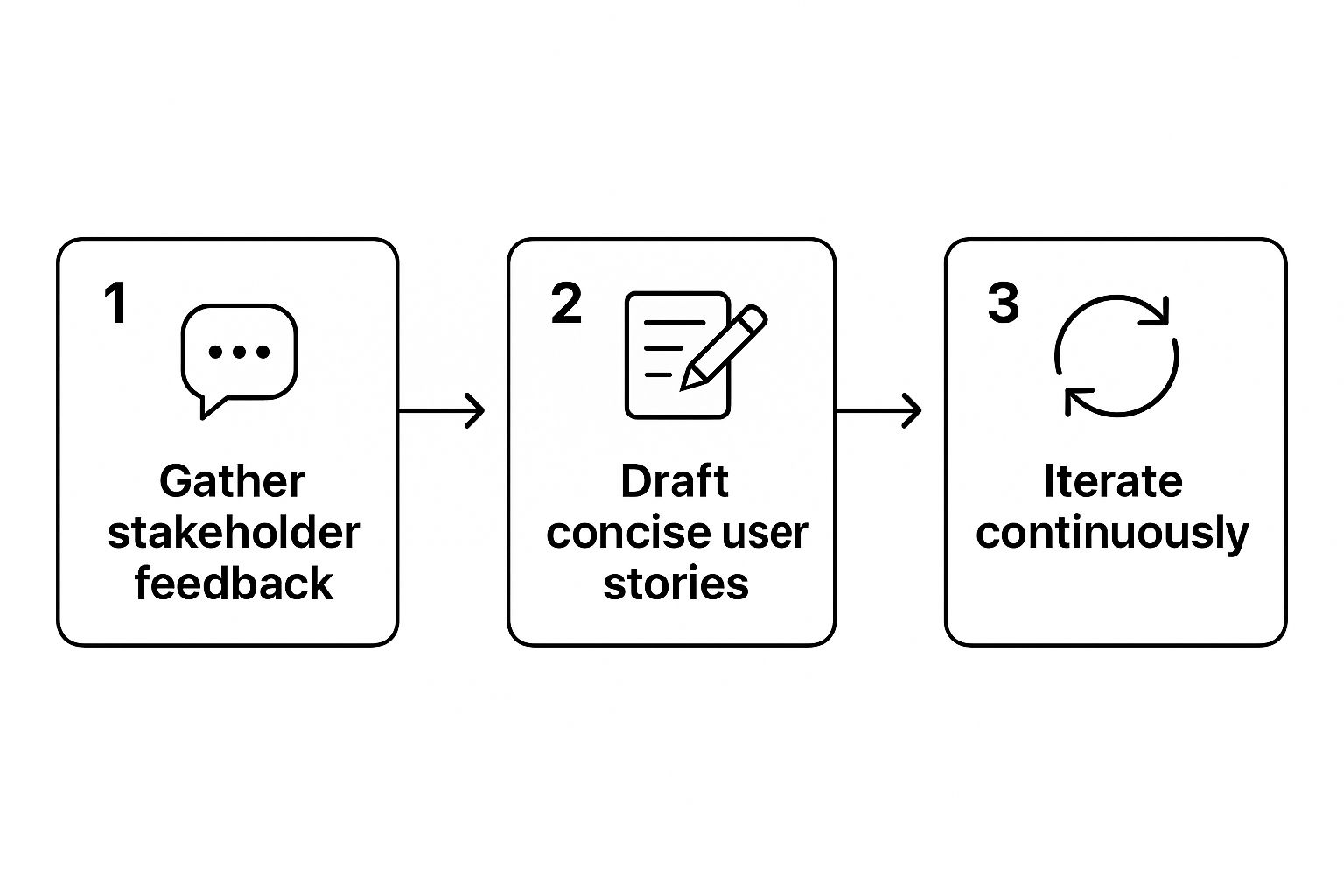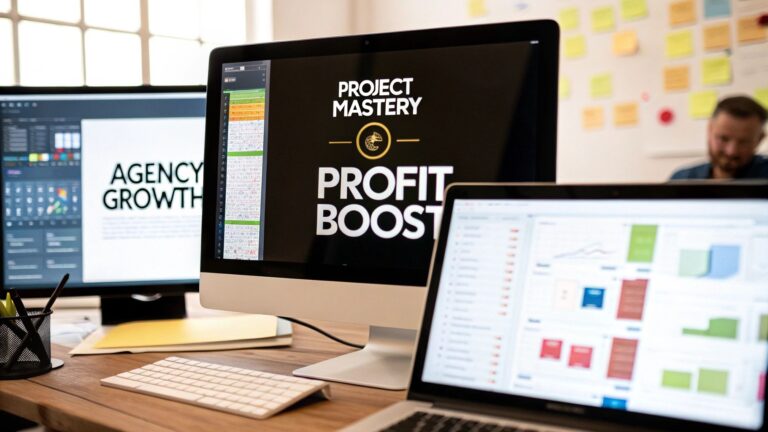Mastering Documenting Requirements in Agile: A Quick Guide
Let's get one thing straight: documenting requirements in an agile world isn't about writing massive, static novels that no one reads. It's about sparking and supporting ongoing conversations with documentation that's just enough. The whole idea is to create lightweight, evolving artifacts that actually clarify what users need and guide the development team, without grinding everything to a halt. We're aiming for collaboration and flexibility, not rigid, upfront specs.
The Agile Documentation Myth: Rethinking Requirements

One of the biggest myths I still hear is that agile means "no documentation." This comes from a fundamental misunderstanding of the Agile Manifesto, which famously values "working software over comprehensive documentation." The key word there is over, not instead of. The point was never to kill documentation entirely; it was to escape the soul-crushing, bureaucratic paperwork that plagued old-school waterfall projects.
The truth is, documenting requirements in agile is absolutely critical. This is especially true for remote or distributed teams who can't just huddle around a whiteboard anytime a question pops up. The real shift is from creating exhaustive tomes to producing lean, purposeful artifacts that actually help people work together and bring clarity to the chaos.
What Is Lean Documentation?
At its heart, lean documentation is about creating the simplest, most effective documentation you need to get the job done—and nothing more. It’s all about value, not volume. So, instead of a 100-page software requirements specification, you might have a collection of well-crafted user stories, clear acceptance criteria, and a high-level story map. This way, every single piece of documentation has a clear purpose and isn't just created "for the sake of it."
Adopting this mindset helps teams sidestep a few classic traps:
- Documentation as a Contract: In waterfall, the requirements document was often a rigid contract between the business and IT. Agile documentation is a conversation starter, not the final, unchangeable word.
- Analysis Paralysis: Teams can get bogged down trying to define every single detail before writing a line of code. Lean documentation encourages you to add details just in time, as you learn more.
- Outdated Information: Let’s be honest, long documents are almost always out of date. Living documents, like a shared wiki in Confluence or a well-managed backlog in Jira, can be updated in seconds.
The real challenge isn't about writing less; it's about writing smarter. Effective agile documentation should be a living, breathing part of the development process that supports the team's ability to deliver value, not a historical record of initial assumptions.
Ultimately, you need to shift your focus from producing perfect documents to achieving a shared understanding across the team. Whether that understanding is captured in a user story, a quick wireframe, or a simple diagram, the format matters far less than its ability to get everyone aligned and moving forward.
Core Techniques for Agile Requirements
When it comes to agile documentation, the goal is to spark collaboration and build a shared understanding, not to create a dense, static manual that nobody reads. Successful teams lean on dynamic, user-focused methods to capture what needs to be built. This way, everyone from developers to stakeholders is on the same page about the product's vision.
One of the most powerful tools in our arsenal is the simple but effective user story. Mastering the art of writing effective user stories is a cornerstone of agile requirements. These aren't just technical specs; they are short, simple descriptions of a feature told from the perspective of the person who actually wants it. This simple shift reframes the entire conversation from "what the system does" to "what the user needs to accomplish."
The classic template, "As a [type of user], I want [some goal] so that [some reason]," is so effective because it forces the team to build empathy. It makes you think about the who, what, and why behind every single feature, ensuring that every bit of development work ties directly back to real user value.
Creating High-Impact User Stories
Of course, not all user stories are created equal. I've seen plenty that are too vague, too big, or just plain confusing. To make sure a story is actually ready for a development team to pick up, it should follow the INVEST criteria. Think of it as a quick quality check.
A solid user story should be:
- Independent: Can it be built and delivered without being tangled up with other stories?
- Negotiable: Is it a conversation starter, not a rigid contract? The best stories leave room for collaborative refinement.
- Valuable: Does it deliver tangible value to the end-user? If not, why are we building it?
- Estimable: Can the team give a rough estimate of the effort involved?
- Small: Is it small enough to be completed within a single sprint?
- Testable: Do we have clear criteria to prove it’s done and working correctly?
This simple flow shows how feedback is gathered, translated into user stories, and continuously refined throughout the process.

It’s a perfect illustration of the agile loop: documentation isn't a one-and-done event but an ongoing, iterative practice that flexes as you learn more.
Clarifying with Acceptance Criteria
A user story gives you the "why," but acceptance criteria define the "what." These are the specific, pass/fail conditions that a feature must meet before it can be marked as complete. You can think of them as the "Definition of Done" for a single piece of work.
Let’s take a simple user story: "As a user, I want to reset my password." The acceptance criteria would then nail down the specifics:
- The password must be at least 12 characters long.
- It must contain one uppercase letter, one number, and one special character.
- The user receives an email confirmation after a successful reset.
Clear criteria like this eliminate ambiguity and make testing a whole lot easier. It's the difference between "I guess it works" and "I know it's done right."
Aligning Teams with Behavior-Driven Development
For more complex features, Behavior-Driven Development (BDD) is a fantastic way to get business and technical folks speaking the same language. BDD uses a simple, natural language format called Gherkin to describe how a feature should behave from the user's point of view.
The Gherkin syntax revolves around Given-When-Then statements:
- Given: The initial state or precondition.
- When: The specific action the user takes.
- Then: The expected result.
BDD Scenario in Action
Given I am logged into my account
And I have items in my shopping cart
When I click the "Checkout" button
Then I should be taken to the payment page
This format is brilliant because it turns abstract requirements into concrete, testable examples that anyone can understand. It closes the communication gap, ensuring that what the team builds is exactly what the business expects. It's a different way of thinking compared to older models, and you can learn more about the distinctions between https://makeautomation.co/project-management-waterfall-vs-agile/.
Comparing Agile Documentation Techniques
So, which technique should you use? It really depends on the situation. User stories are your everyday workhorse, while BDD is great for hammering out complex logic. Here’s a quick breakdown to help you decide.
| Technique | Best For | Key Benefit | Potential Challenge |
|---|---|---|---|
| User Stories | Capturing user needs and prioritizing features. | Fosters empathy and focuses on user value. | Can be too high-level without solid acceptance criteria. |
| Acceptance Criteria | Defining the specific "done" conditions for a story. | Eliminates ambiguity and simplifies testing. | Can become a long, unmanageable checklist if not concise. |
| Behavior-Driven Development (BDD) | Aligning business and tech teams on complex features. | Creates a shared language and automatable tests. | Can be overkill for simple features; requires team discipline. |
Ultimately, the best approach is often a blend of these methods. A well-written user story, backed by clear acceptance criteria and illustrated with a BDD scenario for trickier parts, gives your team everything they need to build the right thing, right.
Choosing the Right Tools for Your Team
Great documentation doesn't do anyone any good if it's buried somewhere no one can find. We can talk about techniques for documenting requirements all day, but the platforms you use are what really bring those ideas to life—especially when your team is spread out. The goal isn't to chase the shiniest new tool with a million features. It’s about finding something that plugs right into how your team already works.
Trying to force a team to change their entire process just to fit a new tool is a classic recipe for disaster. It leads to frustration, and people just won't use it. The right tool should feel like a natural extension of your daily conversations and workflow, making it dead simple to create, find, and update your docs.

This screenshot from Jira is a perfect example. We're looking at a standard agile board where user stories move across the workflow. But the real power here is that each card is more than just a title. It's a living container for conversations, acceptance criteria, attachments, and mockups—it becomes the central hub for everything related to that specific requirement.
Agile Management Platforms as Documentation Hubs
Most agile teams are already practically living inside a project management tool like Jira, Azure DevOps, or even Trello. These platforms are fantastic places to start with documentation because they tie your requirements directly to the actual work. With a little thought, you can turn them into powerful documentation hubs.
Think about a Jira ticket. It's not just a one-line task. You can pack a ton of context into its description field:
- The full user story with all its narrative detail.
- A clear, bulleted list of acceptance criteria.
- Embedded wireframes or links to Figma designs.
- Links out to deeper technical specs or architectural diagrams.
This approach keeps everything in one spot. A developer doesn’t have to go digging through a separate wiki or a shared drive to figure out what a task is about. All the context they need is right there, attached to the work item itself. This tight integration is a cornerstone of good agile documentation.
The best documentation tool is often the one your team is already using every single day. By building on top of your existing project management platform, you eliminate the learning curve and make documentation a seamless part of the development cycle.
When to Use Collaborative Wikis and Dedicated Tools
While keeping documentation close to the code is great for day-to-day work, sometimes you need a home for the bigger picture stuff. This is where collaborative wikis like Confluence or Notion really come into their own. These tools serve as the single source of truth for higher-level information that doesn't belong in a single user story.
I'm talking about things like:
- The overall product vision and strategy.
- Detailed user personas and customer journey maps.
- System architecture diagrams and data models.
- Overarching non-functional requirements (e.g., security, performance).
For teams working in heavily regulated fields like finance or healthcare, a dedicated requirements management tool might even be non-negotiable. These tools are built for strict traceability and compliance. The latest versions are even getting smarter, with features like embedded traceability metrics and AI-powered analysis that can spot ambiguous language in your requirements before a single line of code gets written. That alone can save an incredible amount of rework. You can learn more about what to look for when choosing requirements management tools.
In the end, most successful teams I've worked with land on a hybrid approach. They use Jira for the nitty-gritty of user stories and sprint planning, and they use Confluence for the long-term, big-picture documentation. By seamlessly linking between the two, they get the best of both worlds: tactical clarity for developers and strategic alignment for the whole team.
Finding the Sweet Spot: How Much Detail Is Enough?
Let's talk about the classic agile tightrope walk: how do you move fast without causing a mess? It's the core dilemma of documenting requirements. Too little detail, and your team is left guessing, which almost always leads to rework. But too much detail, and you've just created a bottleneck that grinds all that agile momentum to a halt.
Finding this balance isn't some mystical art form; it’s a conscious strategy. The secret isn't about writing less, but about timing when you write it.
This is where a concept called progressive elaboration comes into play, and frankly, it's a game-changer. Instead of trying to nail down every single detail from the start, you add layers of detail right before the development team needs them. This “just-in-time” approach keeps the team focused on what’s next and ensures the information is always fresh and relevant.
So, How Much Is "Just Enough"?
I wish I could give you a magic formula, but the truth is, the right level of detail changes with every team and every project. It comes down to your specific context—your team’s experience, the project's gnarliness, and how much risk you're willing to stomach.
A senior team that’s been in the trenches together for years? They might just need a solid user story and a quick chat. A junior team tackling a brand new, complex domain will need a lot more support.
To find your own "just enough," think about these things:
- Team Experience: A seasoned team shares a kind of hive mind. They have a deep, almost unspoken understanding of the product, so a simple user story is often all they need to get rolling.
- Project Complexity: Documenting a basic login form is a world away from mapping out a multi-step checkout flow that has to juggle third-party payment gateways. The more moving parts, the more detail you'll need.
- Risk and Impact: Pushing a change to your main e-commerce checkout page is a high-stakes move. An update to an internal admin tool? Not so much. Higher risk demands more rigorous documentation—think wireframes, flowcharts, or detailed acceptance criteria to get everyone on the same page.
The pressure to ship is always on. We see it in the data all the time. Around 47% of agile teams are measured by on-time delivery, which puts this need for speed front and center. At the same time, agile organizations boast a 70% improvement in time-to-market. That incredible speed doesn't happen by accident; it's fueled by effective, lightweight documentation. You can dig into more of these project management statistics if you're curious.
From a Simple Story to a Clear Picture
Let's make this real. Imagine your team is building a new customizable dashboard for your users.
You'd probably start with a simple user story for the backlog: "As a user, I want to rearrange widgets on my dashboard so I can prioritize the information that matters most to me."
Perfect. That’s all you need for now. But as that story moves up the priority list and gets closer to a sprint, it’s time to progressively elaborate. The team might decide that a quick wireframe is the best way to show the drag-and-drop interaction. Maybe they'll sketch out a simple diagram to show how the new layout gets saved.
The goal is to always use the simplest tool that gets the job done. Sometimes, a 10-minute conversation is enough. Other times, a picture really is worth a thousand words.
When you approach it this way, documentation stops being a chore and starts being a strategic tool. You tailor the detail to the task at hand, providing clarity exactly when and where it's needed. This is how you keep your team moving fast without ever sacrificing quality.
Weaving Documentation into Your Agile Ceremonies

Here’s a secret I’ve learned over the years: great documentation isn’t a task you assign. It’s a habit you build. It should be a natural byproduct of the conversations and decisions your team is already having every single day.
When you start weaving documentation directly into your agile ceremonies, it stops feeling like a chore. It becomes a collaborative, living practice that keeps everyone on the same page. This simple shift makes documenting requirements a shared responsibility, not just one person’s problem. The result? The quality and accuracy of your requirements will go through the roof.
Backlog Refinement: Your Collaborative Writing Session
Think of backlog refinement (or grooming) as more than just prioritizing tickets. It's your prime opportunity to turn fuzzy ideas into concrete, buildable requirements. This is where the real work of defining "what" and "why" happens.
In a solid refinement session, the team should be actively doing two things:
- Defining Acceptance Criteria as a Team: A Product Owner might come with the initial user story, but it’s the whole team—devs, QA, designers—that should hammer out the acceptance criteria together. This is how you uncover technical gotchas and edge cases before a single line of code is written.
- Adding the Right Artifacts: Does a story feel a bit complex? Now is the time to decide if you need a quick wireframe, a data flow diagram, or maybe a link to a related technical spike. Attach these artifacts directly to the story in a tool like Jira or Trello so all the context is in one place.
A well-refined story is one that any developer on the team can pick up and immediately understand what needs to be done. No guesswork required.
Sprint Planning: The Final Sanity Check
Sprint planning is your last line of defense against ambiguity. Before you commit to the work, this is the moment to confirm that every story’s documentation is truly “ready.” The team should be asking tough questions and poking holes in the requirements.
A core goal of sprint planning should be to walk out with zero lingering questions. If a developer asks for clarification on a story, the answer shouldn't just vanish into thin air. It needs to be captured immediately in the story's description or acceptance criteria for all to see.
This practice is critical. It stops that "I thought we talked about this" confusion dead in its tracks and ensures the understanding you build in the meeting sticks around for the entire sprint. It's also the perfect time to identify recurring tasks and create or update your Standard Operating Procedures. If you need a framework for that, our guide on how to create SOPs is a great place to start.
Sprint Review: Turning Feedback into Action
Finally, the sprint review is so much more than a demo. It’s a live feedback session that feeds directly back into your documentation. When stakeholders see and touch the new functionality, they will give you pure gold.
Listen for comments like, “Oh, what happens if I click this?” or “I actually thought it would do that instead.” Every one of those observations is an opportunity. Your job is to capture them on the spot—either by creating new stories in the backlog or by adding notes to your product wiki. This closes the loop, ensuring valuable user feedback drives the next iteration instead of getting lost in an email chain.
Common Questions About Agile Documentation
Even with the best intentions and solid techniques, some questions pop up again and again when teams start documenting requirements. People tend to get tangled up in the "what-ifs," and that's completely normal. Let's clear up some of the most common points of confusion I see in the field.
Getting these answers straight from the start will save you a ton of headaches down the road.
How Should We Handle Non-Functional Requirements?
This is a classic. How do you deal with those big, overarching needs like performance, security, or accessibility? Non-functional requirements (NFRs) often feel too massive to fit into a neat little user story. The trick is to stop treating them as abstract ideas and start making them concrete and visible.
Here are a few practical ways I’ve seen teams successfully tackle NFRs:
- As Acceptance Criteria: Bake it right into a relevant story. For instance, a story about a new gallery feature might include: "The page must load in under 2 seconds on a standard connection."
- As Separate Stories: Sometimes, an NFR is big enough to warrant its own story. You might create one that reads, "As a user, I need the system to be secure against common SQL injection attacks." This makes the work visible and easy to prioritize.
- In the Definition of Done: For standards that apply to everything, add them to your team's Definition of Done (DoD). A great example is, "All new endpoints must pass security vulnerability scans before they can be considered 'done'."
Who Is Responsible for Writing Documentation?
Short answer: it's a team effort. While the Product Owner is the one who is ultimately accountable for the product backlog and its contents, the actual writing and refining process is highly collaborative.
The PO usually gets the ball rolling by drafting the initial user stories, but that's just the first pass.
The real magic happens during backlog refinement sessions. This is where developers and QA engineers jump in to add critical technical details and flesh out the acceptance criteria. Designers will link out to their latest mockups, and the entire team chips in with questions that poke holes in assumptions. Shared ownership is what makes the documentation truly useful.
Think of it this way: The Product Owner owns the what and the why, but the entire team owns the clarity. Effective documentation is a team sport, not a solo assignment.
If your team is trying to bring some consistency to this process, looking at different business process documentation templates can give you a great head start. It helps ensure everyone is speaking the same language as you grow.
At MakeAutomation, we specialize in creating efficient, scalable frameworks that turn process chaos into clarity. Learn how our AI and automation solutions can optimize your project management workflows.







